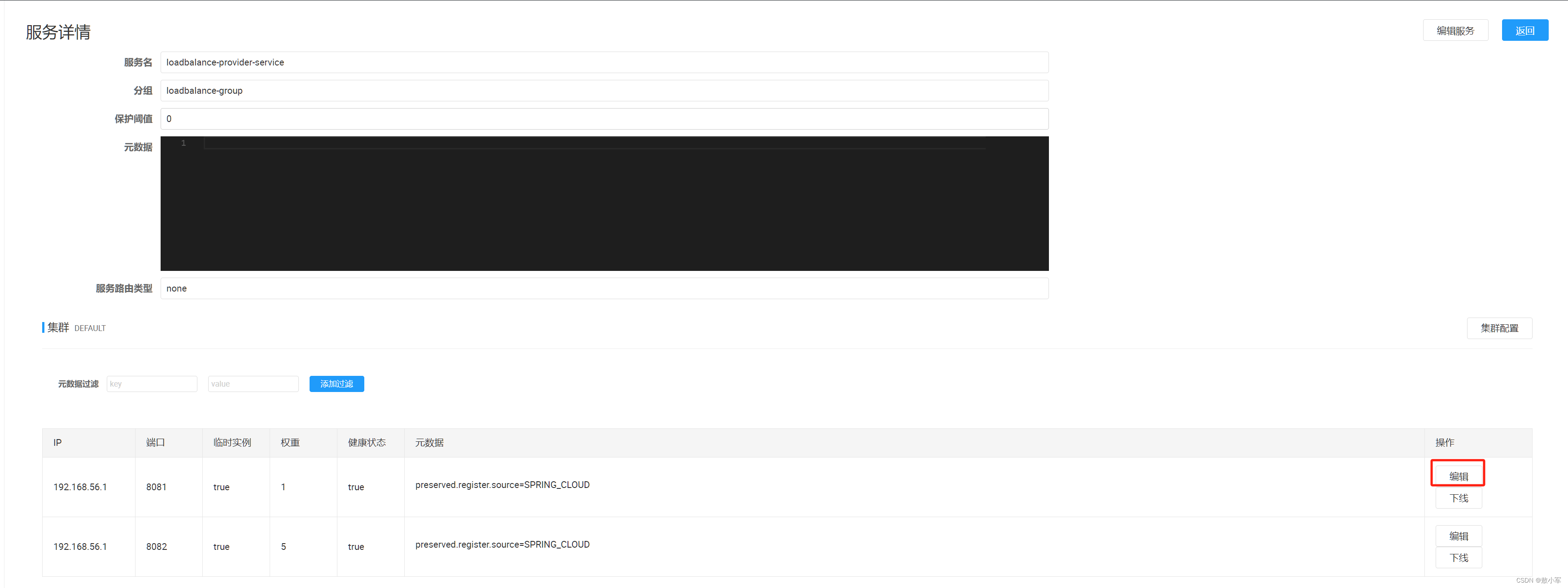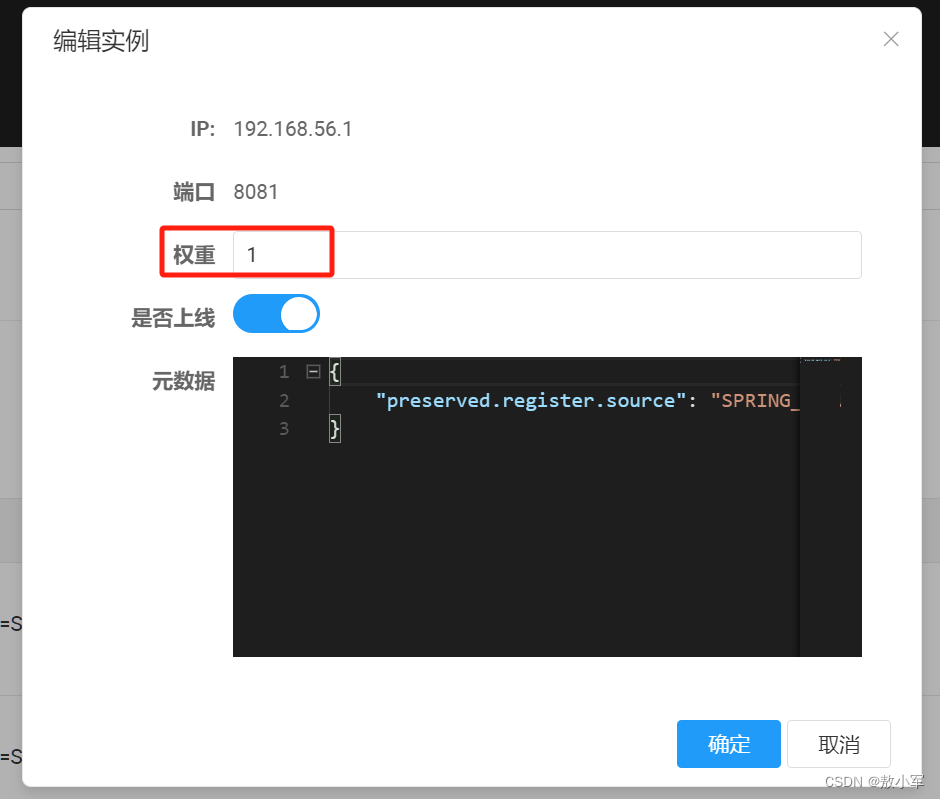ReactorLoadBalancer接口,实现自定义负载算法需要实现该接口,并实现choose逻辑,选取对应的节点
public interface ReactorLoadBalancer<T> extends ReactiveLoadBalancer<T> { Mono<Response<T>> choose(Request request); default Mono<Response<T>> choose() { return this.choose(REQUEST); } }
RoundRobin算法核心源码
private Response<ServiceInstance> getInstanceResponse(List<ServiceInstance> instances) { if (instances.isEmpty()) { if (log.isWarnEnabled()) { log.warn("No servers available for service: " + this.serviceId); } return new EmptyResponse(); } else { //通过cas的position变量自增,循环 % 实例数。 int pos = Math.abs(this.position.incrementAndGet()); ServiceInstance instance = (ServiceInstance)instances.get(pos % instances.size()); return new DefaultResponse(instance); } }
nacos权重
nacos可以配置不同实例的权重信息,可以在
- yaml中配置
spirng.cloud.nacos.discovery.weight数值范围从1-100 ,默认为1 - 可以在nacos面板找到该实例信息,并实时配置实例的权重
基于nacos权重实现自定义负载
权重:数值越高,代表被选取的概率越大.
根据RoundRobin源码,自定义NacosWeightLoadBalancer
package cn.axj.loadbalancer; import org.apache.commons.logging.Log; import org.apache.commons.logging.LogFactory; import org.springframework.beans.factory.ObjectProvider; import org.springframework.cloud.client.ServiceInstance; import org.springframework.cloud.client.loadbalancer.DefaultResponse; import org.springframework.cloud.client.loadbalancer.EmptyResponse; import org.springframework.cloud.client.loadbalancer.Request; import org.springframework.cloud.client.loadbalancer.Response; import org.springframework.cloud.loadbalancer.core.*; import reactor.core.publisher.Mono; import java.util.*; import java.util.concurrent.ThreadLocalRandom; /** * 基于nacos权重的负载均衡 */ public class NacosWeightLoadBalancer implements ReactorServiceInstanceLoadBalancer { private static final Log log = LogFactory.getLog(NacosWeightLoadBalancer.class); private final String serviceId; private ObjectProvider<ServiceInstanceListSupplier> serviceInstanceListSupplierProvider; //nacos权重获取名称,在nacos元数据中 private static final String NACOS_WEIGHT_NAME = "nacos.weight"; public NacosWeightLoadBalancer(ObjectProvider<ServiceInstanceListSupplier> serviceInstanceListSupplierProvider, String serviceId) { this.serviceId = serviceId; this.serviceInstanceListSupplierProvider = serviceInstanceListSupplierProvider; } @Override public Mono<Response<ServiceInstance>> choose(Request request) { ServiceInstanceListSupplier supplier = this.serviceInstanceListSupplierProvider.getIfAvailable(NoopServiceInstanceListSupplier::new); return supplier.get(request).next().map((serviceInstances) -> { return this.processInstanceResponse(supplier, serviceInstances); }); } private Response<ServiceInstance> processInstanceResponse(ServiceInstanceListSupplier supplier, List<ServiceInstance> serviceInstances) { Response<ServiceInstance> serviceInstanceResponse = this.getInstanceResponse(serviceInstances); if (supplier instanceof SelectedInstanceCallback && serviceInstanceResponse.hasServer()) { ((SelectedInstanceCallback)supplier).selectedServiceInstance(serviceInstanceResponse.getServer()); } return serviceInstanceResponse; } private Response<ServiceInstance> getInstanceResponse(List<ServiceInstance> instances) { if (instances.isEmpty()) { if (log.isWarnEnabled()) { log.warn("No servers available for service: " + this.serviceId); } } else { //根据权重选择实例,权重高的被选中的概率大 //nacos.weight的值越大,被选中的概率越大 Double totalWeight = 0D; for (ServiceInstance instance : instances) { String s = instance.getMetadata().get(NACOS_WEIGHT_NAME); double weight = Double.parseDouble(s); totalWeight = totalWeight + weight; //放置当前实例的权重区间 instance.getMetadata().put("weight",String.valueOf(totalWeight)); } //随机获取一个区间类的数值,nacos权重越大,区间越大,则随机数值落到相应的区间的概率是由区间的大小来决定的。 double index = ThreadLocalRandom.current().nextDouble(totalWeight); //根据权重区间选择实例 for (ServiceInstance instance : instances) { double weight = Double.parseDouble(instance.getMetadata().get("weight")); if (index <= weight) { return new DefaultResponse(instance); } } } return new EmptyResponse(); } }
配置使用
增加WeightLoadBalanceConfiguration
public class WeightLoadBalanceConfiguration { @Bean public ReactorLoadBalancer<ServiceInstance> weightLoadBalancer(Environment environment, LoadBalancerClientFactory loadBalancerClientFactory) { String name = environment.getProperty(LoadBalancerClientFactory.PROPERTY_NAME); return new NacosWeightLoadBalancer(loadBalancerClientFactory .getLazyProvider(name, ServiceInstanceListSupplier.class), name); } }
修改主类配置
@LoadBalancerClients({ @LoadBalancerClient(name = "loadbalance-provider-service", configuration = WeightLoadBalanceConfiguration.class) })


